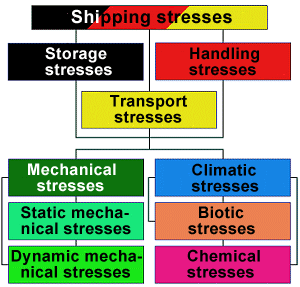- avoidable shipping stresses
- unavoidable shipping stresses
Unavoidable shipping stresses are determined by the nature of the transport operation and lie largely outside the sphere of human influence.
Very large numbers of incidents of damage are attributable to the fact that many of those involved in shipping are unaware of shipping stresses or assess them incorrectly. This ought not to be the case as information of this kind is available from many different sources. Section 1 "General conditions" in the CTU packing guidelines provides important information about how cargoes are affected particularly during voyages. Information about road, rail and inland waterway transport and about cargo handling is also provided. In addition, the German vehicular accident prevention regulations (BGV D 29) and VDI guidelines also state values for road transport. Values for the stresses arising in rail transport may be obtained from publications from the German railroad company Deutsche Bahn AG or the UIC.
It is not without reason that the CTU packing guidelines contain the following important statement in the point Scope:
-
These Guidelines are not intended to conflict with, or to replace or supersede, any existing regulations or recommendations which may concern the carriage of cargo in CTUs.
-
Carriage denotes the movement of cargo using one or more modes of transport.
The stresses arising during shipping may thus be summarized as shown below:
 |
Overview of shipping stresses |
It is extremely difficult to put exact values on storage, handling and transport stresses because they are determined by many different parameters. In addition to the stresses shown in the overview, other factors of course also play a part, such as the means of transport used, the selected routes, the nature of the roads and railroads or the particular weather conditions prevailing during maritime transport.
Protection from shipping damage may be provided with regard to economic viability without consequently being less effective. Effective and economic protective measures can be implemented if enough is known about the stresses to which the cargo is exposed during transport.
As experience has shown and measurements have confirmed, the shipping stresses of different modes of transport differ markedly. Nevertheless, there are similarities and common features which should be taken into account in the following explanations.
However, it is not feasible to generalize about transport operations, each one will be somewhat different and will also be affected by randomly occurring factors. The better trained are those involved, the better will they be able assess the transport risks and take effective action to counter them. Training and quality control are two key concepts which should play a central part in cargo securing.